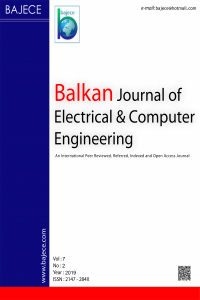Abstract
In this paper, average symbol error rate
(ASER) performance of rectangular quadrature amplitude modulation (RQAM) scheme
is analyzed over α-η-µ fading channels. First, an ASER expression is derived
based on Chernoff approximation of Gaussian Q-function.
Then, an asymptotic ASER formula is obtained for analyzing system behavior at
high signal-to-noise ratio (SNR) regime. The ASER performance is presented for
different modulation levels and fading parameter values. In addition, relative
truncation error (RTE) is illustrated in order to determine how many terms are
needed for the computation of proposed expression. It is shown that analytical
results are in close agreement with exact results.
Keywords
References
- [1] D. Dixit, , P.R. Sahu, “Performance analysis of rectangular QAM with SC receiver over Nakagami-m fading channels”, IEEE Communications Letters, Vol.18, No.7, 2014, pp.1262-1265.
- [2] D. Dixit, P. R. Sahu, “Symbol error rate of rectangular QAM with best-relay selection in cooperative systems over Rayleigh fading channels”, IEEE Communications Letters, Vol.16, No.4, 2012, pp.466-469.
- [3] G. K. Karagiannidis, “On the symbol error probability of general order rectangular QAM in Nakagami-m fading”, IEEE Communications Letters, Vol.10, No.11, 2006, pp.745-747.
- [4] X. Lei, P. Fan, L. Hao, “Exact symbol error probability of general order rectangular QAM with MRC diversity reception over Nakagami-m fading channels”, IEEE Communications Letters, Vol.11, No.12, 2007, pp.958-960.
- [5] N. Kumar, P. K. Singya, V. Bhatia, “ASER analysis of hexagonal and rectangular QAM schemes in multiple-relay networks”, IEEE Transactions on Vehicular Technology, Vol.67, No.2, 2018, pp.1815-1819.
- [6] N. Kumar, V. Bhatia, “Exact ASER analysis of rectangular QAM in two-way relaying networks over Nakagami-m fading channels”, IEEE Wireless Communications Letters, Vol.5, No.5, 2016, pp.548-551.
- [7] V. Asghari, D.B. da Costa, S. Aissa, “Symbol error probability of rectangular QAM in MRC systems with correlated η-µ fading channels”, IEEE Transactions on Vehicular Technology, Vol.59, No.3, 2010, pp.1497-1503.
- [8] N. Kapucu, M. Bilim, I. Develi, “Outage performance of cooperative DS-CDMA systems with best path selection over α-η-µ fading channels”, Electronics Letters, Vol.53, No.11, 2017, pp.752-754.
- [9] O.S. Badarneh, M.S. Aloqlah, “Performance analysis of digital communication systems over α-η-μ fading channels”, IEEE Transactions on Vehicular Technology, Vol.65, No.10, 2016, pp.7972-7981.
- [10] M.K. Simon, M.-S. Alouini, Digital Communication over Fading Channels, John Wiley & Sons, 2000. [11] I.S. Gradshteyn, I.M. Ryzhik, Table of Integrals, Series and Products, Academic Press, 2000.
- [12] S.S. Soliman, N.C. Beaulieu, “The bottleneck effect of Rician fading in dissimilar dual-hop AF relaying systems”, IEEE Transactions on Vehicular Technology, Vol.63, No.4, 2014, pp.1957-1965.
Abstract
References
- [1] D. Dixit, , P.R. Sahu, “Performance analysis of rectangular QAM with SC receiver over Nakagami-m fading channels”, IEEE Communications Letters, Vol.18, No.7, 2014, pp.1262-1265.
- [2] D. Dixit, P. R. Sahu, “Symbol error rate of rectangular QAM with best-relay selection in cooperative systems over Rayleigh fading channels”, IEEE Communications Letters, Vol.16, No.4, 2012, pp.466-469.
- [3] G. K. Karagiannidis, “On the symbol error probability of general order rectangular QAM in Nakagami-m fading”, IEEE Communications Letters, Vol.10, No.11, 2006, pp.745-747.
- [4] X. Lei, P. Fan, L. Hao, “Exact symbol error probability of general order rectangular QAM with MRC diversity reception over Nakagami-m fading channels”, IEEE Communications Letters, Vol.11, No.12, 2007, pp.958-960.
- [5] N. Kumar, P. K. Singya, V. Bhatia, “ASER analysis of hexagonal and rectangular QAM schemes in multiple-relay networks”, IEEE Transactions on Vehicular Technology, Vol.67, No.2, 2018, pp.1815-1819.
- [6] N. Kumar, V. Bhatia, “Exact ASER analysis of rectangular QAM in two-way relaying networks over Nakagami-m fading channels”, IEEE Wireless Communications Letters, Vol.5, No.5, 2016, pp.548-551.
- [7] V. Asghari, D.B. da Costa, S. Aissa, “Symbol error probability of rectangular QAM in MRC systems with correlated η-µ fading channels”, IEEE Transactions on Vehicular Technology, Vol.59, No.3, 2010, pp.1497-1503.
- [8] N. Kapucu, M. Bilim, I. Develi, “Outage performance of cooperative DS-CDMA systems with best path selection over α-η-µ fading channels”, Electronics Letters, Vol.53, No.11, 2017, pp.752-754.
- [9] O.S. Badarneh, M.S. Aloqlah, “Performance analysis of digital communication systems over α-η-μ fading channels”, IEEE Transactions on Vehicular Technology, Vol.65, No.10, 2016, pp.7972-7981.
- [10] M.K. Simon, M.-S. Alouini, Digital Communication over Fading Channels, John Wiley & Sons, 2000. [11] I.S. Gradshteyn, I.M. Ryzhik, Table of Integrals, Series and Products, Academic Press, 2000.
- [12] S.S. Soliman, N.C. Beaulieu, “The bottleneck effect of Rician fading in dissimilar dual-hop AF relaying systems”, IEEE Transactions on Vehicular Technology, Vol.63, No.4, 2014, pp.1957-1965.
Details
| Primary Language | English |
|---|---|
| Subjects | Electrical Engineering |
| Journal Section | Araştırma Articlessi |
| Authors | |
| Publication Date | April 30, 2019 |
| Published in Issue | Year 2019 Volume: 7 Issue: 2 |
Cited By
ASER of SISO system with rectangular QAM scheme over α-μ fading channels
International Journal of Electronics Letters
Rajkishur Mudoi
https://doi.org/10.1080/21681724.2020.1870718
All articles published by BAJECE are licensed under the Creative Commons Attribution 4.0 International License. This permits anyone to copy, redistribute, remix, transmit and adapt the work provided the original work and source is appropriately cited.


